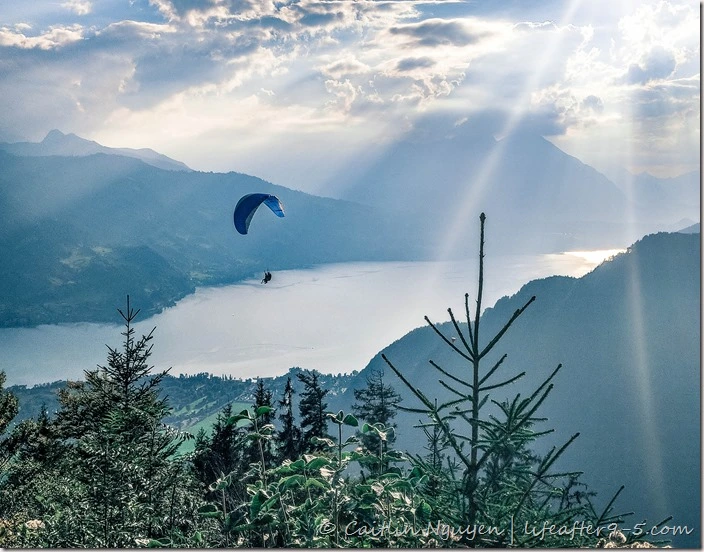
View of Lake Brienz from Harderkulm
Disclosure: A big thank you to Hertz, Eurowings and Bürgenstock Resort Spa for sponsoring this post and making our Switzerland road trip very memorable. As always, all opinions are 100% my own and I would not recommend something that I don’t personally believe is awesome.
Switzerland has been at the top of my bucket list forever, so when Hertz and Eurowings contacted me about a partnership to promote their new route, I could not resist. I called up my sister Kim and planned an impromptu scenic road trip around Switzerland. I was excited to finally see iconic Swiss sights like alpine villages, wooden chalets, rolling green hills and glacial lakes with my sister. Switzerland has natural beauty in abundance so you can’t really take a bad picture, and every scene looks like it came straight out of a postcard.
A road trip through the picturesque mountain passes and the jaw-dropping landscapes is the best way to experience the country. There are inspiring panoramic views at every turn and driving allowed us to see them all at our own pace. We spent 4 days driving ourselves around the Bernese Oberland region exploring the many villages, lakes and mountains in the area. This comprehensive guide and road trip itinerary will outline the route, drive times, accommodations, and restaurant suggestions to help you plan your OWN trip. The itinerary is broken out by day, with ideas on where to stop and what to see at each location.
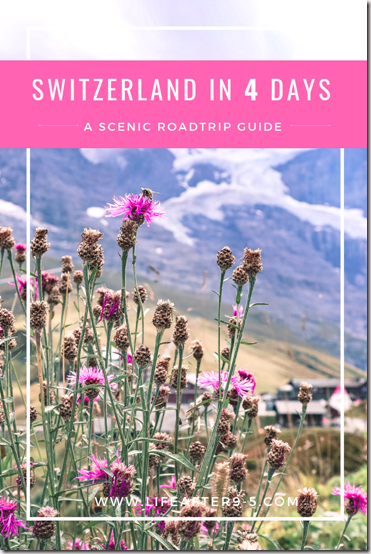

Our Trip Detail
Duration: 4 Days
Dates Visited: Sept 15 – Sept 19
Distance Covered: 400 miles
Travel Style: Road trip with lots of stops
Important Information
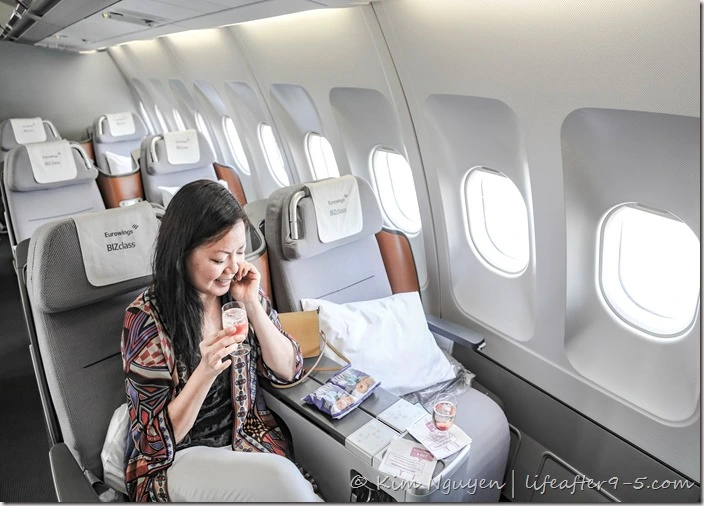
Eurowings Business Class cabin
Getting There
I traveled to Switzerland with Eurowings on their new direct route from NYC to Dusseldorf. I was excited to find out that there are more budget flight options to Europe. It is cheaper to fly to Europe than to the West coast. From Eurowings’ Dusseldorf hub, I can easily fly to many other European cities. On the flight out, we were seated in the Best Cabin. This is a great option if you want extra comfort for a reasonable price. The Best fare comes with premium seating, extra leg room, free checked bags and a meal. Even though it was not a lie flat bed, the chair reclined quite a bit more than seats in economy, and since it was a red-eye, the comfortable seat allowed me to get some shut eye before we landed. On our 4 hour layover in Dusseldorf we went to the Hugo Junkers lounge using my Priority Pass to grab some food and relax before our flight to Zurich. On the flight back, we flew Eurowings Business Class. We were both excited because it was Kim’s first time flying business class. It was nice to have a lie flat seat where we could curl up under our big comforter and watch a movie. They also had an extensive menu of food and drink options. I love gin and tonic, so I couldn’t wait to try the Siegfrid gin from a Rheinland distillery, which was nice and mellow. But if gin is not your thing, you can also get a variety of wine, craft beer and other top shelf liquors on the flight. For our lunch we had many great meal choices, but my absolute favorite was the final cheese course with the Tete de Moine cheese rosette. To top it off, before we landed, we were given a travel drink kit as a parting gift. The whole experience starting with our special welcome drink to when we got to JFK was great!
Trip Tip: Don’t forget to get to the airport nice and early. With the new regulations, there are more security and check points in place and it takes longer to get to the gate.
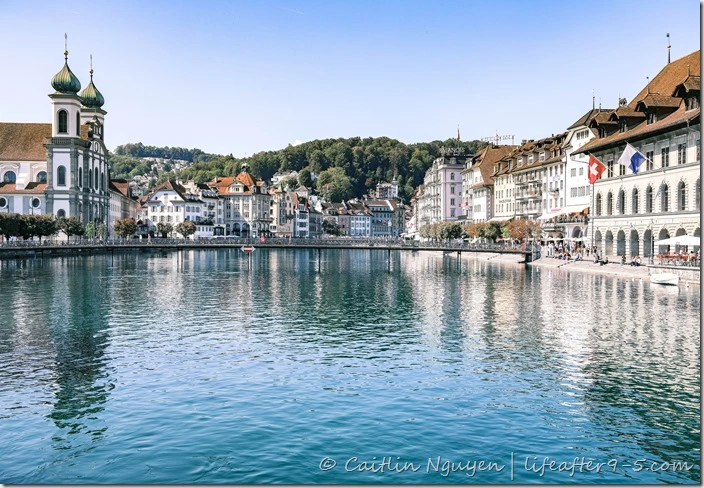
View of Lucerne from Kappelbrücke
When To Go
The best time to go to Switzerland depends on the activities you have planned. July and August are the summer high season, and January and February are the winter high season. To avoid the peak season crowds, you should go during the shoulder months like March or September. When we were there in mid September, the weather was still sunny and beautiful, but not too hot. It was the perfect time to spend outdoors exploring.
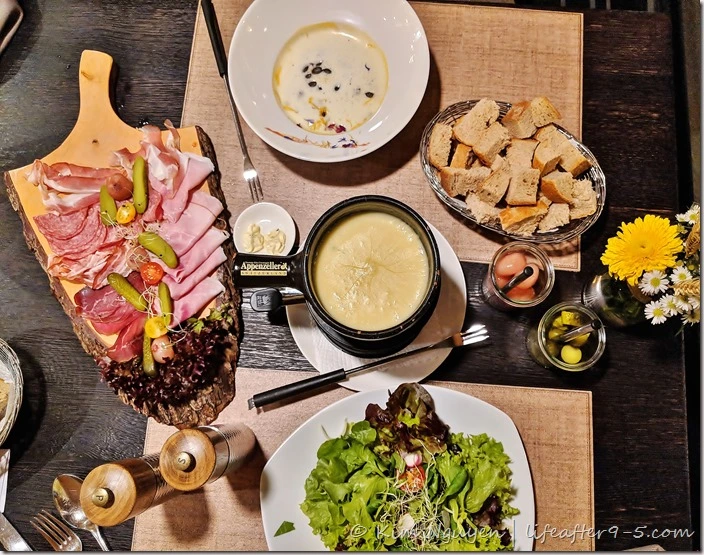
Traditional Swiss meal of cheese fondue
What to Eat
A country’s food habits often reflect its cultural diversity as well as regional characteristics and Switzerland is no different. While we were in this great country we tried a few of the hearty traditional dishes like rösti, fondue and raclette. Rösti originated from Bern, a hearty dish favored by local farmers usually eaten at breakfast before they start their day, but now you can find these pan-fried grated potatoes as a side dish with other Swiss favorites. Cheese fondue is another iconic dish eaten for centuries by Swiss herders living in the mountains who relied on fondue as a way to use bread and cheese in the colder months. It’s a dish where people dip breads and meat into a big communal pot of melted cheese mixed with wine and garlic, and served with pickled onions on the side. I tried fondue for the first time in Switzerland and honestly, it did not taste as I expected. Instead of the creamy cheesy taste, it tasted a little off-putting and overwhelmingly like white wine. Raclette is a dish of semi-hard cheese melted and scraped over potatoes and meat and served with pickled vegetables. This was our favorite dish of the trip because, who doesn’t love melted cheese! It also goes without saying that you have to try the the chocolate because Switzerland is home of many world famous chocolatiers.
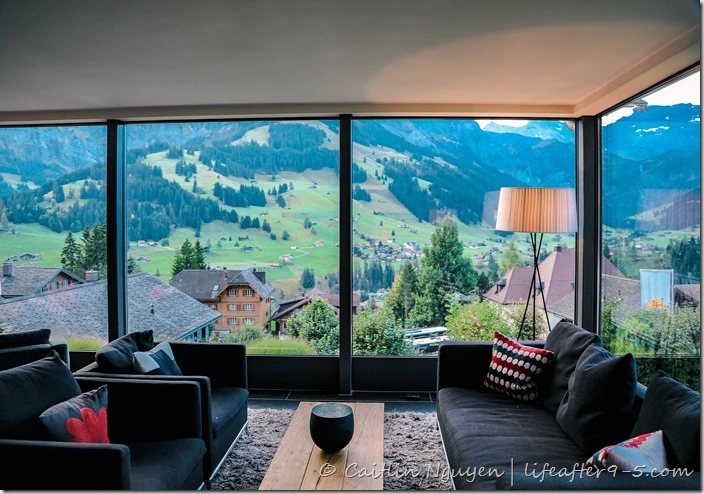
View of Adelboden from Cambrian hotel
Where To Stay
Finding affordable accommodations last minute in Switzerland is an impossible feat. Hotels, chalets, and airbnbs were either all booked up or ridiculously expensive with some rooms rates over a thousand dollars a night. To book our place I used a combination of booking.com and airbnb, but the choices were quite limited. We choose to pay extra for balconies and mountain views, but it was unnecessary because we didn’t get to the hotel until late every night and left right after breakfast each morning, so we never got to enjoy it. Besides, you’ll be surrounded by gorgeous mountain views everywhere you go. The one bonus is that most of the hotels come with free breakfast which is great because we could eat before starting our day. Included in the itinerary is a list of our accommodations for the trip.
What to Pack
Deciding what to pack for Switzerland largely depends on when you go and what kind of activities you have planned. For our mid-September trip, I found that layers are a must for Switzerland’s quick-changing weather and higher altitudes. A few essentials include:
- a day pack to carry a water bottle, camera and snacks
- light weight rain jackets
- a sturdy pair of walking shoes to explore the stunning landscapes
- warm layers
- cameras, tripod and battery
- sunglasses because it can get very bright up in the mountains
- bathing suit if you’re staying at a place with a pool

View of surrounding mountains from Swiss road
Getting Around
Switzerland has a great public transportation system that will take you everywhere you need to go, but if you’re there for a short time and want to fit in a lot of sightseeing then a car is the way to go. But even if you have a car, you still have to take the train/cable car/gondola up to the mountains since some alpine villages are completely car free. Train travel in Switzerland is top-notch and convenient, but it also costs a lot money. If you want to save, make sure to look into different travel discount passes like the Swiss Travel Pass, the Half Price Pass or the Savor Day Pass and see which one makes the most sense for you. The Half Price Pass is good for multiple days, offering trains and cable cars for half price. The Swiss Travel Pass is good for multiple days and allows you to take the train and bus for free and cable car for 50% off. The drawback is that it costs 200 CHF+ per adult for 3 days. The day pass is similar to the Swiss Travel Pass but only good for a day and costs 100 CHF. If you plan on doing a lot of train travel, these passes are totally worth it. It didn’t make sense for us because we were only there for a few days and only planned to visit a few villages, although each time when we paid full price for the train ride up to the mountains, we wished we had these passes. A cheap alternative to taking the train is to hike or bike up the mountain trails, but it’s a much longer time commitment.
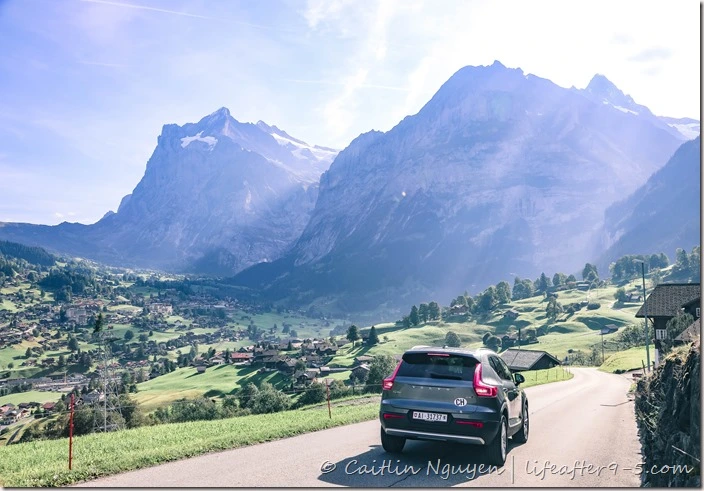
Switzerland road trip
Driving in Switzerland
You know that I am a big fan of road trips, especially if I don’t have to drive. The car allowed us a lot of flexibility to go around at our own pace and make unscheduled stops for photographs or to admire nature. The Swiss Alps, with its windy roads, mountain passes and gorgeous landscapes is a dream to drive. We were completely awe-struck by the beauty of Switzerland. Even though the country is pretty small and the villages are close together, we opted to stay in the Bernese Oberland region since our time was limited .
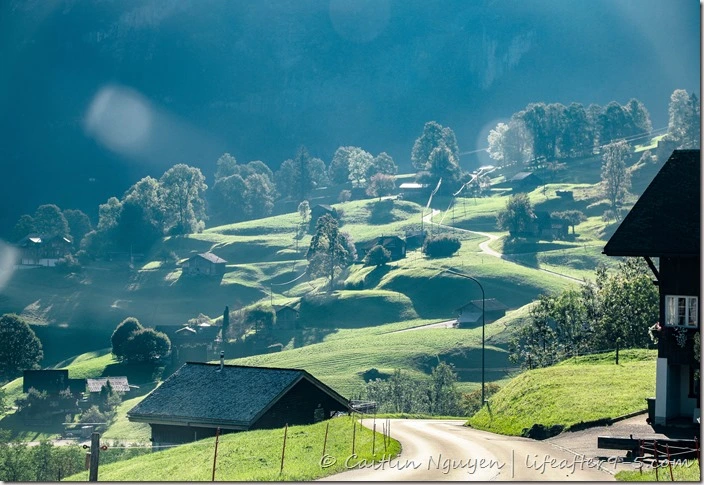
Driving through Swiss countryside
Roads
Driving in Switzerland was pretty easy as long as you’re comfortable navigating narrow mountain roads. We were a little nervous about the serpentine roads, but quickly realized that it was not as hard as we imagined as long as we went slow around the bends. All the roads are paved and well maintained but the signage can be confusing. There were times where we were not sure if we were driving down a one way road; in those times, we pulled over and double checked just to be safe. Another thing to realize is that the roads can get very dark once you’re outside of city limits, so if you are not comfortable driving in the dark, make sure you set aside plenty of time to get to your destination before sunset.
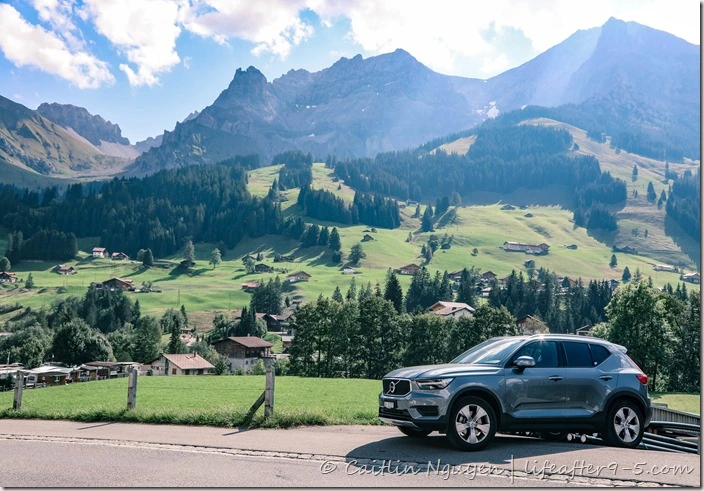
View of Swiss scenery from the road
Car Rental
We are loyal Hertz customers so we were very excited to have this opportunity to collaborate with a brand that we use and would recommend. Once we landed at Zurich Airport, we walked over to the car rental area to pick up our vehicle. The check-in process was seamless. We walked up directly to the agent who asked us to fill out a form and provide our license and passport information. He found our reservation and told us that the car was ready. The only hard thing we had to do was decide if we wanted to get the comprehensive insurance, which was a bit expensive. After debating for a few minutes, we decided to go with the insurance since we were a little nervous about driving windy mountainous Swiss roads. The whole check-in process took about 10 minutes.
We got a Volvo 4WD SUV which we named Val (short for Valkyrie) for the duration of the trip. Val was easy and comfortable to drive once we got used to all the settings. We loved that Hertz provided us with a parking disc and vignette which allows you to drive on the toll roads. Usually a vignette sticker costs 40 CHF to purchase and can be picked up at a gas station or online. We got to the Zurich later than expected and not having to worry about taking toll roads saved us a lot of time. We grew quite attached to our car over the course of the trip and were sad when we had to say goodbye. The return process was just as fast and easy. We parked, packed up our stuff, and a person came to check the car and mileage and we were on our way.
Maps
I use Google My Maps to help me plan my trip and figure out where everything is and how long it takes to get to each place. While in Switzerland, we used Google Maps exclusively to help us navigate. From my experience, Google Maps is accurate and got us where we needed to go most of the time. There were a few instances where the directions were a bit confusing and we had to circle back, but it was not a big deal. We also had great internet on the road and didn’t have to worry about downloading offline maps, but you can do that if you’re worried about losing signal.
Gas
Gas is very expensive in Switzerland at about about $1.70 USD a liter or $6.50 a gallon! Luckily our rental car was very fuel efficient, we only went through about half a tank for the duration of our 4 day trip. Paying for gas is pretty easy because most gas stations in Switzerland take credit cards.
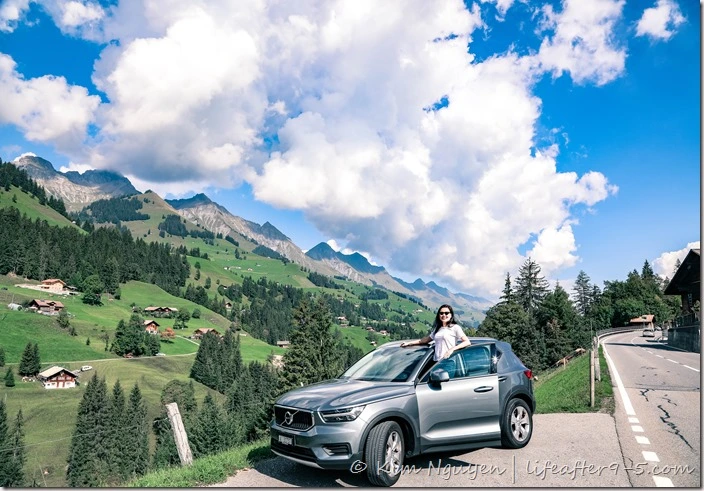
Scenic road trip around Switzerland
Switzerland Road Trip Itinerary
The following is our quick 4-day road trip itinerary including all the places we visited, accommodations, and restaurant guide to give you an idea when you plan your own trip. We decided to spend time in the Bernese Oberland, the most beautiful region in Switzerland. Our route starts in Zurich and forms a clockwise circle: Grindelwald – Lauterbrunnen – Aldebolden – Interlaken – Lucern – Zurich. Each day averages about one to two hours of driving time, with many stops along the way. Make sure you leave plenty of time to enjoy each place. Follow me on Instagram to see more photos from Switzerland.
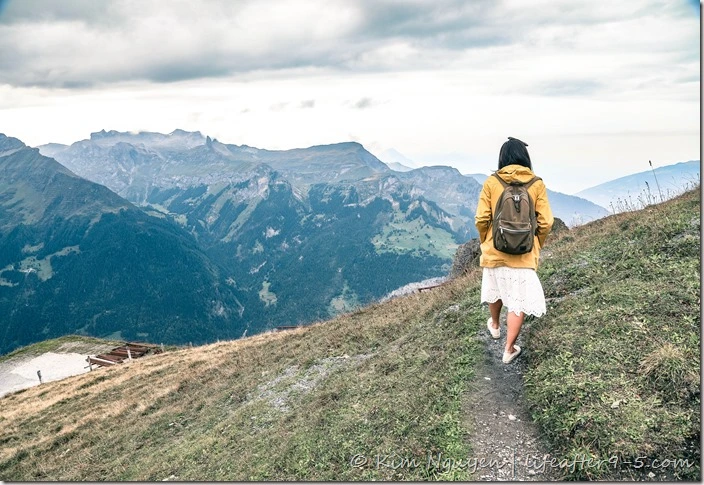
Hiking in Kleine Scheidegg
Day 0 and 1: Zurich → Grindelwald
(140 KM, 2:10 HOURS)
We flew in the night before, arriving in Zurich at 6 pm. By the time we got our luggage, picked up our car at the Hertz counter and hit the road, it was 7 pm. It took us a while to get used to our new car and the windy mountain roads. Even in the dusk, we couldn’t help but marvel at the gorgeous scenery and the cute little chalets and cottages dotting the mountainside. We didn’t end up getting to the hotel until 9:30 pm, then grabbed a quick dinner and called it a night. The next morning we got up early to enjoy the gorgeous mountain view from our bedroom. We were planning on taking it easy for our first day. There was not too much driving involved since we planned on visiting the nearby town of Lauterbrunnen and its surrounding mountains and villages. We decided against going to Jungfrau, the highest point in Europe, because it was cloudy that day and we wouldn’t be able to see much.
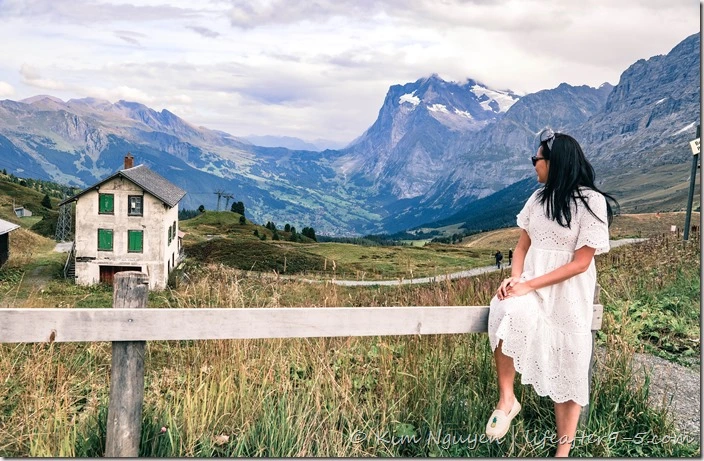
View of valley from Kleine Scheidegg
Stops
- Kleine Scheidegg– It is a mountain pass located 2,061m above the Lauterbrunnen and Grindelwald valleys and sits in the shadow of the the towering Eiger, Mönch and Jungfrau peaks. To get to Kleine Scheidegg you can take a train from Lauterbrunnen that costs 60 CHF per person for round trip tickets. Make sure to sit on the right side on the train going up for the best views. The summit of Kleine Scheidegg is the ideal starting location for the Jungfraujoch and countless other hikes. If you’re not into hiking you can just find a place to sit and admire the view of the surrounding mountains.
- Wengen – After Kleine Scheidegg, we took the train back down to Wengen where we hung out for the rest of the afternoon. Wengen is a charming mountain village above the Lauterbrunnen Valley that is only accessible by train and is completely car-free. We walked around the main square, visited a few stores and took pictures of this cute town. If you’re looking to take the iconic picture of the waterfalls towering over Lauterbrunnen, walk down to the church where the old and new tracks converge.
- Männlichen – This 2,343m mountain in the Swiss Alps can be accessed via cable car from Wengen or Grindelwald. From Wengen, the journey takes about 10-15 minutes and costs 46 CHF per person round trip. Once you’ve arrived at the terminus, you can take a leisurely stroll on the Royal Walk path to the lookout point. The 20 minute steep vertical climb can be a bit taxing at this altitude, but it’s totally worth the view. At the top, you get a 360 degree view over the Lauterbrunnen Valley and the surrounding mountains of Eiger, Mönch and Jungfrau. Check the weather before you go because the mountaintops are covered on cloudy days.
- Lauterbrunnen – The striking village of Lauterbrunnen nestled in a valley, surrounded by rocky cliffs and the roaring waterfalls is the inspiration for Rivendell, the idyllic elven city in the Lord of the Rings books. Once you arrive, it’s easy to see why J. R. R. Tolkien was so smitten by this little piece of heaven. Lauterbrunnen is located in the heart of the Swiss Alps making it the ideal base to visit the surrounding mountains and villages to enjoy all the alpine activities.
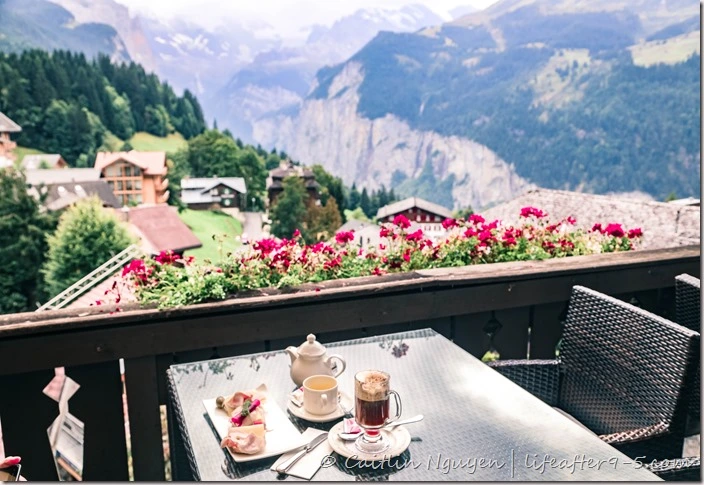
View of Lauterbrunnen valley
Accommodation: Our first two nights, we stayed at the Aspen Alpine hotel, a luxury hotel on the outskirts of Grindelwald. We had splurged and booked a room with a balcony overlooking the mountains, and were very disappointed when we were not given one. The room we stayed in had a nice view of the mountains, but there was no balcony like the picture on Booking.com suggested. For a 4 star hotel with rates over 350 CHF per night, the room and customer service left much to be desired. The location of the hotel is also remote and hard to find, especially at night. Overall, I would not recommend this place as I think you can find better accommodations elsewhere for much cheaper.
Dinner: We had dinner right at the Aspen Alpine hotel on our first night in Switzerland. We were tired and didn’t want to go too far. The steak tartar and poached salmon were ok, but the herb butter was divine. This is a good option if you stay around this area, but I wouldn’t go out of my way to eat here. The next night, we had dinner at Hotel Oberland in Lauterbrunnen. This place serves all the traditional Swiss favorites like rosti, fondue and raclette. The restaurant was quite busy, but they were able to fit us in if we promised to be out in an hour and a half. Since we were not that hungry, we decided to share a mixed salad, escargot, and locally made sausage with rosti. The rosti was good, because how can you go wrong with crispy potatoes, but the sausage was really dry.

Cliff walk from Grindelwald First
Day 2: Grindelwald → Adelboden
(60 KM, 1:12 HOURS)
Our second day was jam-packed with activities, lookout points, and even more villages. There are so many cute alpine villages around Grindelwald that even after two days we still hadn’t visited them all. The most memorable part of our day was having a beer up in Harder Kulm while watching the paragliders. We could have spent a whole day at any one of these stops, but due to the lack of time, this was a good overview of the area.
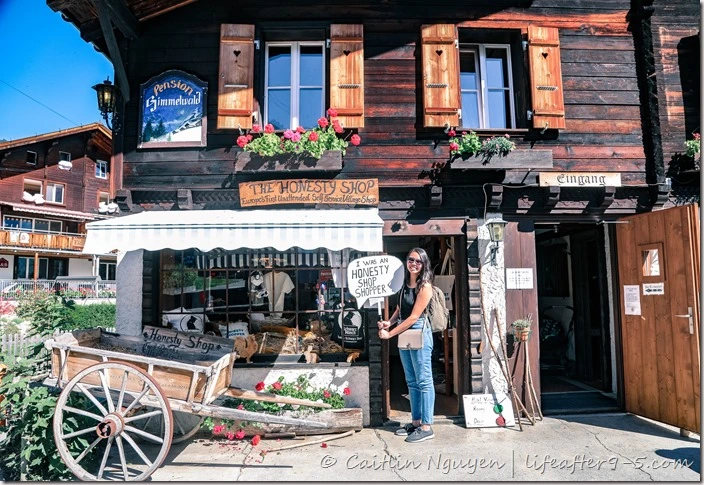
Honesty shop in Gimmelwald
Stops
- Grindelwald First – We started the day at Grindelwald First, a popular destination for adventure seekers and mountain lovers. To get to the top, we paid 42 CHF for a round trip ticket with discount from the hotel. The gondola ride takes about 20-25 minutes to get to the top. Once you’re at the top, you can do the cliff walk, hike to an alpine lake, take a leap with the First Flyer, scoot down the mountain on a trottibike and many other adrenaline filled activities. Since the cliff walk is very popular there is always a long line of people waiting to take pictures. If you want the same view with less people, walk over to the restaurant and take the stairs down to the little nearby hill where you’ll find a nice bench. The bench has the best view of the Eiger North Face with no one else around.
- Gimmelwald – Gimmelwald is a small village in the Bernese Oberland, located about halfway up the mountain between Stechelberg and Mürren. Most people go straight to Mürren, but you can get off and spend some time in Gimmelwald. The round trip ticket costs 22 CHF per person. Gimmelwald is a tiny village where everyone operates on the honesty system. You’ll find lots of storefronts with no cashiers, so if you buy anything, you just pay into the cash box. Without any tourists around, the quaint village of Gimmelwald is the perfect place to experience authentic Swiss countryside.
- Mürren – Mürren is a Swiss mountain village at the foot of the Schilthorn peak. It is much bigger and busier than Gimmelwald, filled with shops, restaurants and people. This village looks like something that came straight out of a story book. The wooden houses decorated with bright flower boxes lined the main square while the snow-capped mountains loomed in the background. There are also many park benches around if you want to take a break to enjoy the scenery. There are lots of places to take photos, but our favorite was the open area near Tham Snacks & Drinks Chinese Restaurant.
- Harderkulm – Our last stop of the day is Harderkulm, a lookout point at the top of Interlaken. Again you pay the exorbitant fee of 32 CHF per person to take an 8 minute gondola to the top. From there you can go to the platform overlooking the two lakes, Lake Thun and Lake Brienz and wonderful views of the Eiger, Mönch & Jungfrau mountains. Everyone made a bee line to the lookout, but if you head towards the pavilion and turn down the path to the right, you will be rewarded with great views away from the crowd. Aside from the viewing platform there is also a restaurant at the top complete with reclining chairs and benches, perfect for sitting back and admiring the view with a beer and snacks. We sat there and watched the peaceful scene with paragliders gracefully floating over the lake.
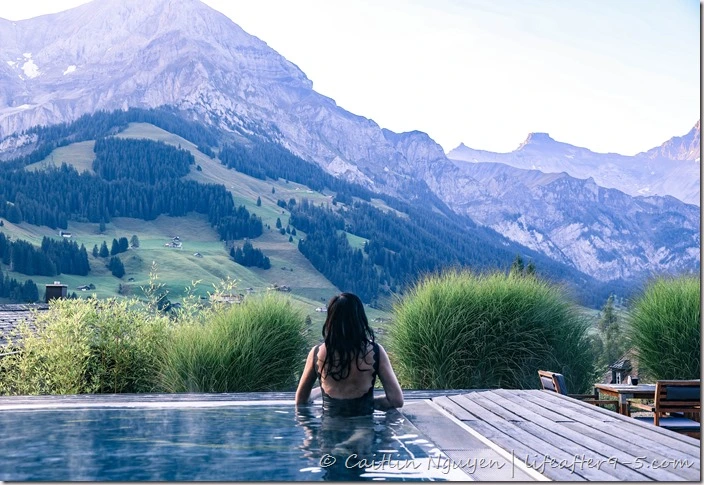
View from pool at Cambrian hotel
Accommodation: The Cambrian is one of the most iconic luxury hotels nestled in the cute village of Adelboden overlooking the panoramic views of the Swiss Alps. It’s almost impossible to express the magnificent beauty of this landscape in words or with pictures. The balcony, terraces, and outdoor heated pool overlook the lush green valley dotted with red-roofed chalets and surrounded by snowy peaks. We definitely wish we had stayed here longer than a day to explore the town and enjoy the facilities.
Dinner: We went to Hotel Restaurant Baren for dinner, a place that serves good traditional Swiss fondue recommended by our hotel. I’ve never had cheese fondue before and was expecting a pot of thick melted cheese where you dip your bread. Instead I found that the fondue has a more watery texture and tastes strongly of white wine. After asking my Swiss friends I found out that it’s quite normal and alcohol is expected to be incorporated into the dish. Personally, I was not a big fan of the taste.
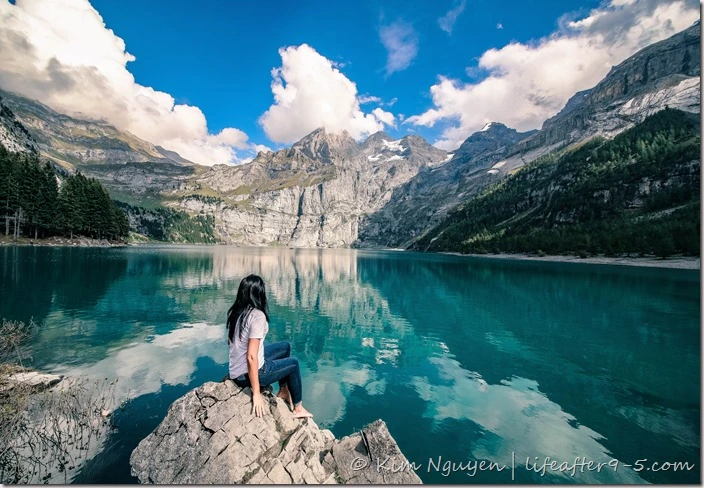
Admiring the view at Oeschinensee
Day 3: Adelboden → Lucerne
(115 KM, 2:10 HOURS)
On our third day, we decided to take a break from the alpine villages and visit all the lovely lakes around the Bernese Oberland area. The lakes are so clear and blue, it is a little surreal. I still can’t believe I finally got to see Blausee in person which has been on my bucket list for as long as I can remember. The lakes are incredible but it was hard to pick a favorite because they all have their own unique characteristics.
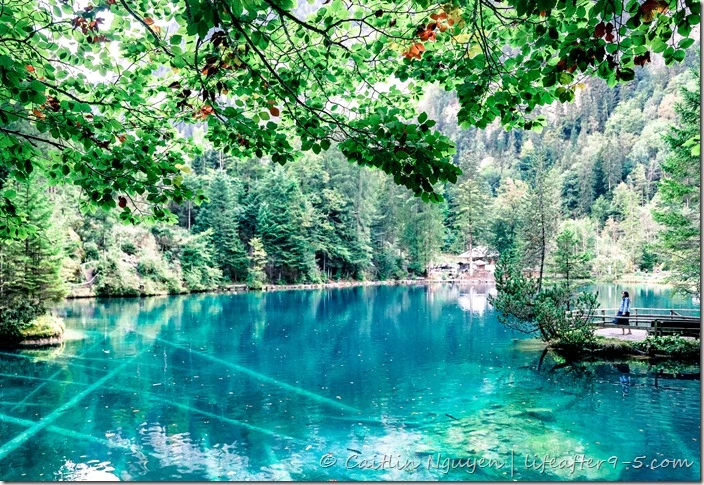
Admiring the view at Blausee
Stops
- Oeschinensee – Our first stop of the day was Oeschinen Lake, a gorgeous lake nestled high in the mountains. We paid 28 CHF for round trip gondola tickets to the top, which is pretty cheap by Swiss standards. The ride takes about 10 minutes, once you’re at the top, it’s another 20 minute walk to the lake. If you want to be active, there is swimming, rowing, hiking and biking, or you can just take it easy sun bathing and picnicking by the lake surrounded by the remarkable scenery. Another fun thing you can do at the summit is the alpine slide, a massive slide on the side of the mountain that you ride down on your toboggan. It was so much fun and only cost 5 CHF per person or 20 CHF for 5 rides. There was so much to do, I could spend at least half a day exploring. The walk back is all uphill and you can choose to take the shuttle, but it costs 8 CHF per person – we opted to walk.
- Blausee – I’ve been in love with this lake ever since I saw pictures of it years ago, but nothing quite prepared me for how beautiful it looks in person. The crystal-clear water, sourced directly from subterranean springs, surrounded by mountains and forests is one of the best-known lakes in Switzerland. It costs 8 CHF per person to visit and the admission fee includes a 15 minute boat tour around the lake. From the boat, you can see right through to the bottom of the lake where you see all the trout swimming around the fallen trees. A little further away, there was a family of ducks peacefully gliding across the water. The lake itself is not very big, so it only takes about 30 minutes to walk the circumference.
- Brienz Lake – We stopped by Brienz Lake briefly for dinner before heading to our hotel for the night. This idyllic blue lake is surrounded by 18th-century wooden chalets on one side and towering mountains on the other. Walk down towards the water and you’ll find a path that takes you around the lake. The perfect time for a stroll is at sunset when the sky turns a soft pastel color.

View from balcony at Seehotel Sternen
Accommodation: For our last night in Switzerland we stayed at the Seehotel Sternen, a hotel located on the edge of Lake Lucerne, about 5-10 minute drive from the city itself. The room comes with parking and free breakfast which is served in the restaurant until 10am. We got a lake view room with a balcony overlooking the peaceful water. I wish we got there earlier to enjoy the view.
Dinner: We picked Seerestaurant Sternen because it was the only place in Brienz still open. The restaurant was closing up, but the waitress agreed to serve us something basic if we ordered right away. We got a mushroom pizza and a salad. The dinner wasn’t great, but the location overlooking the water was perfect and the price was reasonable.
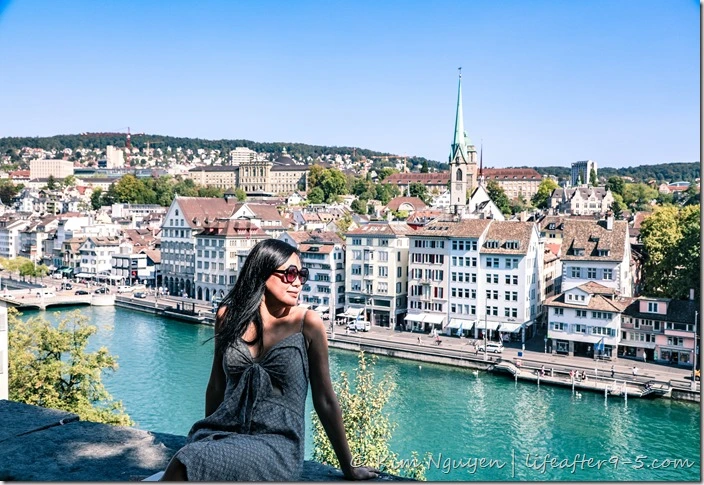
View of Zurich from Lindenhof lookout point
Day 4: Lucerne → Zurich
(53 KM, 41 minutes)
We tried to fit in as much as possible on our last day in Switzerland. The day started at an alpine spa resort with the prettiest pool in the world followed by a short visit to Lucerne for lunch and ended in Zurich, Switzerland’s capital city. The few hours in Zurich gave us a quick overview of what the city has to offer and allowed us to visit some famous Swiss chocolatiers, a must-do on any trip to Switzerland.
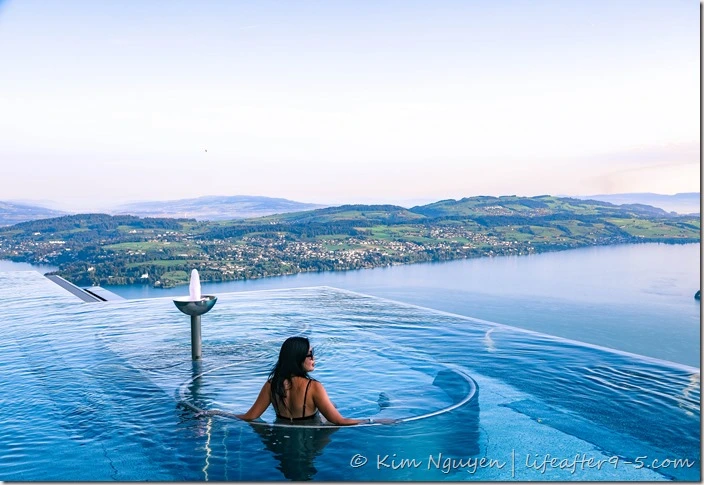
The view from outdoor pool at Bürgenstock Alpine Spa
Stops
- Bürgenstock Alpine Spa – The newly rebuilt Bürgenstock Alpine Spa with its world famous infinity pool overlooking the Lucerne Lake and surrounding mountains is one of the most talked about hotels in Switzerland. The modern architecture, contemporary design and luxurious amenities made this a very enjoyable visit and a great way to end our trip. Bürgenstock Hotel guests will get free access to the spa, while guests of the Palace Hotel, Taverne 1879 and Waldhotel will have to pay 100 CHF per day to visit the spa. For all others, it costs 130 CHF for half day and 180 CHF for full day. The spa entrance fee is steep but it’s totally worth it because you have access to three different pools, a relaxation center and saunas. The infinity pool is heated with water kept at a constant 35 degrees Celsius. While you sit back and enjoy the spectacular landscape the many high pressure water jets will give you a nice massage. Make sure you get there early to have the pool to yourself.
- Lucerne – Even though Lucerne is the most populous city in Central Switzerland it still retains its charm and small-town character. The well-preserved city sits on the edge of the crystal clear Lake Lucerne surrounded by snow-capped mountains. One of Lucerne’s most visited tourist attractions is the Kappelbrücke, or Chapel Bridge, the oldest covered bridge in Europe, originally built in 1333. It spans the Reuss River and provides great views of the city and its architecture. We were only there for a few hours, but we wished we had stayed longer.
- Zürich– Zürich is the biggest and most well-known city in Switzerland, a center for banking and commerce. Despite being a thriving metropolitan center, Zürich has laid-back vibes. The city center is small enough to explore on foot, a perfect way to discover all the cobblestone streets and small shops. When you want to take a break, walk down to the river, where you’ll find a family of ducks and swans frolicking on the clear water. For the best view of the downtown historical center, head up to the Lindenhof lookout point. From this vantage point, you can see landmarks like the Grossmünster and Fraumünster church as well as the Limmat River.
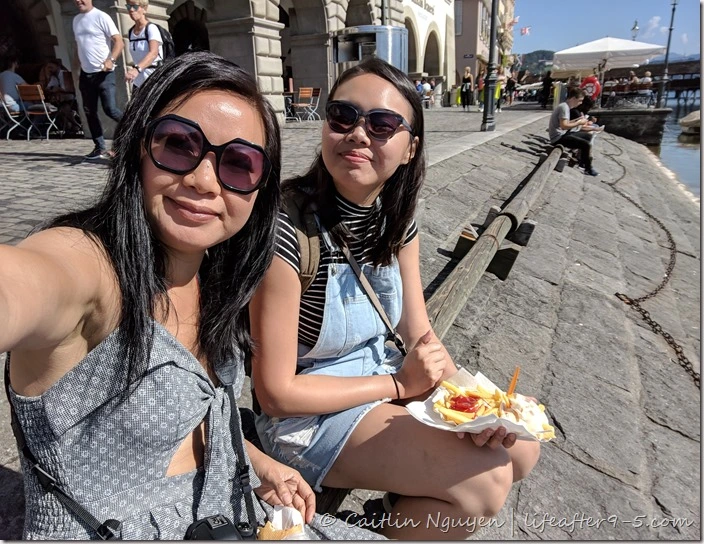
Having lunch by Lake Lucerne
Lunch: We got takeaway from Twiny Station, a small shop in Lucerne Old City with a nice selection of sandwiches on warmed baguettes. Their best seller, the pork schnitzel sandwich, is a winner and the fries were some of the best I’ve ever had. They were soft and fluffy inside and nice and crispy outside. But the best part is that you can take the food down by the lake and soak in the views of the bridge.
Dinner: For our last dinner in Switzerland, we went in search of raclette, a Swiss specialty that consists of scraping melted cheese over potatoes, bread and meat; usually served with pickled onions. This Swiss dish was originally eaten by the mountain herdsman while they lived on the Alps taking care of the cows. Since we were running late, we didn’t have time to go to a proper restaurant, instead we opted to go to The Raclette Factory, a semi fast food place that specializes in this Swiss favorite. We find that we liked this dish much better than fondue. You can’t go wrong with melted cheese over potatoes and bread.

Handmade chocolate from Max Chocolatier
Chocolate Stops: Even if you don’t have a sweet tooth, it would not be right to be in Switzerland without stopping for some chocolate. Switzerland is known for its fine chocolate, with brands like Lindt, Nestle, and Toblerone recognized around the world. I love chocolate, so a trip to Switzerland is not complete without a stop at a few of these world famous chocolatiers. My favorites are Max Chocolatier, and Sprungli. Max is a small family-owned boutique that uses high quality natural ingredients to create unique handmade chocolate. Sprungli is a Swiss confectionery founded almost 200 years ago, well-known for their truffles and macarons. A walk around the Sprungli store is tempting even if you don’t have a sweet tooth.
Like it? PIN it!
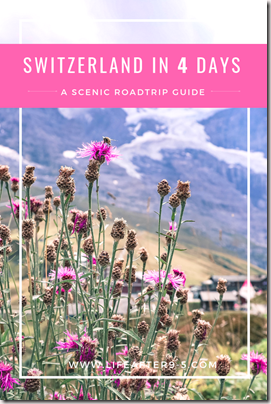


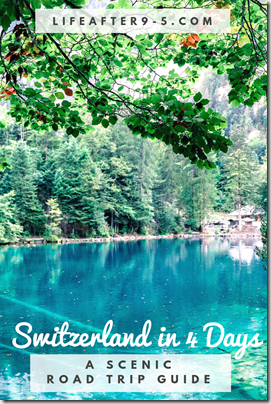


Beautiful photos and a great travel guide!!
LikeLike
Thank you very much! Glad you find it helpful, let me know if you have any other questions
LikeLike
What a cool idea! I never really thought about taking a road trip through Switzerland before, but this looks incredible. Thanks so much for sharing this, I think it’s a great idea. I love the itinerary and it seems like you covered just about everything. Now to see if I can get the boyfriend on board!
LikeLike
Switzerland is so lovely, you can’t really go wrong. Hope you’ll be able to convince your boyfriend to go as well!
LikeLike
Hi¡
What a cool idea! I never really thought about taking a road trip through Switz before, but this looks incredible. Thanks so much for sharing this, I think it’s a great so cool pics idea. I love it so much
Marruecosxtremetours.com
LikeLiked by 1 person
It is such a beautiful country and road trip is the best way to see it
LikeLike
Reading the post brought about some wonderful memories from our vacation. Although we covered the Lake Geneva region more, we did make it to Jungfrau and stayed in Lauterbrunnen for three days. I’ve been writing about our vacation on my blog, buts always lovely to experience Swiss through different eyes. Cheers!
LikeLiked by 1 person
I definitely want to go back and see the other regions of Switzerland one day. It’s just too beautiful for words.
LikeLiked by 1 person
Gorgeous pictures and locales! Switzerland lives up to its name. 🙂
LikeLiked by 1 person
It certainly does, I was just in awe of its beauty the whole time
LikeLiked by 1 person
Beautiful description of a beautiful place! When can we expect more?
LikeLiked by 1 person
Thank you Jackie! am going to get back into blogging and give everyone an update on what I’ve been doing in 2019.
LikeLike
Caitlin – Great photos! I am always in awe and fascinated by your world travels. Wonderful roadtrip tips. I have only been to Lake Lucerne & this was many moons ago when I studied in Paris for a semester abroad in the 80’s. Keep travelling & sharing these wonderful posts. Thank you!
LikeLike
Lovely! Missed hearing from you! Look forward to the next story!
LikeLike